
Philips Angel I (bapt. 14 September 1616 - (after?) October 1683) was a Dutch painter of still lifes.

Philips Angel I (bapt. 14 September 1616 - (after?) October 1683) was a Dutch painter of still lifes.
Philips Angel I left his native Middelburg in 1639 to establish himself as a still life painter in Haarlem. He entered the Haarlem Guild of St. Luke in 1639 and was still mentioned as a member in 1643. [1]
He returned to Middelburg at least in 1652 and remained there until his death.
Philips Angel I's life and work are often mixed up with those of a relative (presumably a cousin), the contemporary painter of the same name (referred to as Philips Angel II or Philips Angel van Leiden), born in 1618 in Leiden. Philips Angel II was active as a painter in Leiden from 1637 to 1645, then sailed to Batavia, Dutch East Indies where he died after 11 July 1664. [2]
Approximately 30 paintings are currently attributed to Philips Angel I, some with dates between 1642 and 1664 or 1668. [3] He was mainly a still life painter. Due to confusion resulting from the signatures and dates which he added to his paintings it is difficult to determine the development of his art with its divergent subgenres, especially his sober still lifes with food, dishes and kitchen-objects sometimes known as ontbijtjes (Dutch for 'breakfast pieces'). [1]
His works fall into three main groups: barn interiors with an emphasis on the still life element, 'ontbijtjes' and still lifes with dead fowl. The influence of Frans Rijckhals can be seen in the first two groups. [1] Ryckhals may have been Angel's teacher in Middelburg.
His 'ontbijtjes' show the influence of Haarlem painters such as Floris van Dyck in their tendency to build compositions from individually studied components and in the rendering of various details. The still lifes with dead fowl belong to his best works and are similar to the game pieces of the Flemish painters Jan Fyt and Alexander Adriaenssen. [1] [3] These works demonstrate Angel's skill at painting fur and feathers. [3]

Ambrosius Bosschaert the Elder was a Flemish-born Dutch still life painter and art dealer. He is recognised as one of the earliest painters who created floral still lifes as an independent genre. He founded a dynasty of painters who continued his style of floral and fruit painting and turned Middelburg into the leading centre for flower painting in the Dutch Republic.

Frans Hals the Elder was a Dutch Golden Age painter, chiefly of individual and group portraits and of genre works, who lived and worked in Haarlem.

Middelburg is a city and municipality in the south-western Netherlands serving as the capital of the province of Zeeland. Situated on the central peninsula of the Zeeland province, Midden-Zeeland, it has a population of about 48,000.

Willem Claesz. Heda was a Dutch Golden Age artist from the city of Haarlem devoted exclusively to the painting of still life. He is known for his innovation of the late breakfast genre of still life painting.
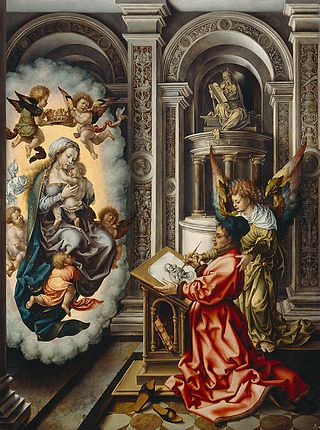
Jan Gossaert was a French-speaking painter from the Low Countries also known as Jan Mabuse or Jennyn van Hennegouwe (Hainaut), as he called himself when he matriculated in the Guild of Saint Luke, at Antwerp, in 1503. He was one of the first painters of Dutch and Flemish Renaissance painting to visit Italy and Rome, which he did in 1508–09, and a leader of the style known as Romanism, which brought elements of Italian Renaissance painting to the north, sometimes with a rather awkward effect. He achieved fame across at least northern Europe, and painted religious subjects, including large altarpieces, but also portraits and mythological subjects, including some nudity.
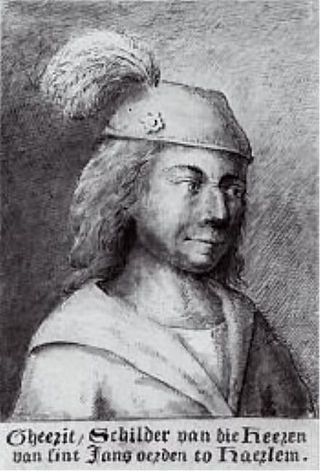
Geertgen tot Sint Jans, also known as Geertgen van Haarlem, Gerrit van Haarlem, Gerrit Gerritsz, Gheertgen, Geerrit, Gheerrit, or any other diminutive form of Gerald, was an Early Netherlandish painter from the northern Low Countries in the Holy Roman Empire. No contemporary documentation of his life has been traced, and the earliest published account of his life and work is from 1604, in Karel van Mander's Schilder-boeck.
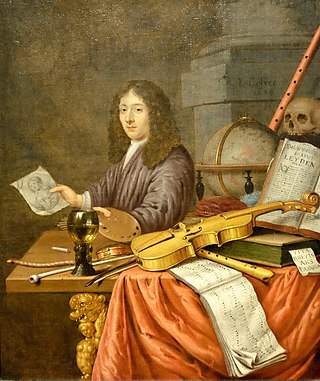
Evert Collier was a Dutch Golden Age still-life painter known for vanitas and trompe-l'œil paintings. His first name is sometimes spelled "Edward" or "Edwaert" or "Eduwaert" or "Edwart," and his last name is sometimes spelled "Colyer" or "Kollier".

Bartholomeus van der Helst was a Dutch painter. Considered to be one of the leading portrait painters of the Dutch Golden Age, his elegant portraits gained him the patronage of Amsterdam's elite as well as the Stadtholder's circle. Besides portraits, van der Helst painted a few genre pictures as well as some biblical scenes and mythological subjects.

Adriaen van Utrecht was a Flemish painter known mainly for his sumptuous banquet still lifes, game and fruit still lifes, fruit garlands, market and kitchen scenes and depictions of live poultry in farmyards. His paintings, especially the hunting and game pieces, show the influence of Frans Snyders. The two artists are considered the main inventors of the genre of the pronkstillevens, i.e. still lifes that emphasized abundance by depicting a diversity of objects, fruits, flowers and dead game, often together with living people and animals. Van Utrecht also painted a number of flower still lifes. He was a regular collaborator with leading Antwerp painters who had been pupils or assistants of Peter Paul Rubens, such as Jacob Jordaens, David Teniers the Younger, Erasmus Quellinus II, Gerard Seghers, Theodoor Rombouts, Abraham van Diepenbeeck and Thomas Willeboirts Bosschaert.
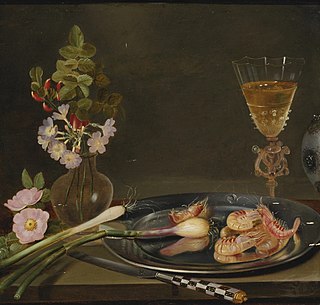
Frans Ykens was a Flemish still life painter active in Antwerp and Brussels in the 17th century. He is mainly known for his flower pieces and fruit still lifes and also painted banquet pieces, pronkstillevens, garland paintings and larger game pieces.
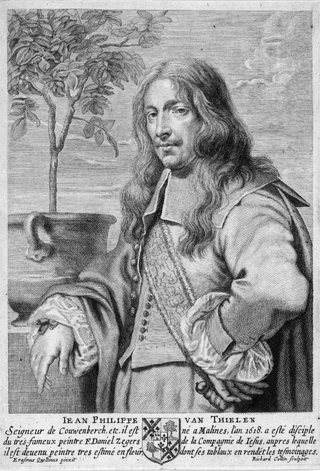
Jan Philip van Thielen or Jan Philips van Thielen was a Flemish painter who specialized in flower pieces and garland paintings. He was a regular collaborator with leading Flemish and Dutch figure painters of his time. Van Thielen was the most popular flower painter in Flanders and his patrons included Diego Felipez de Guzmán, 1st Marquis of Leganés and Leopold Wilhelm of Austria, the art-loving governor of the Southern Netherlands.

Christoffel van den Berghe (c.1590, Antwerp – c.1645, Middelburg) was a Flemish-born Dutch Golden Age painter of landscapes and flower still lifes.

Floris Gerritsz van Schooten or Floris van Schooten was a Dutch painter who practised in a broad range of still life genres including breakfast pieces, fruit pieces, market scenes and large kitchen pieces.

Alexander Adriaenssen was a Flemish Baroque painter, particularly known for his still-lifes of fish and game pieces. He also painted banquet pieces with food and flower still lifes.

Jacob Savery or Jacob Savery the Elder was a Flemish painter, etcher and draughtsman. He was trained in Antwerp and later moved to the Dutch Republic after 1584. He specialised in still lifes, animals, landscapes en genre paintings.
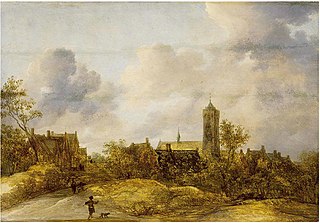
Frans de Momper was a Flemish landscape painter who, after training in Antwerp, worked for a while in the Dutch Republic. Here he was exposed to the work of Dutch landscape painters such as Jan van Goyen. His later paintings prefigure the imaginative landscapes of Hercules Segers.
Philips Angel II or Philips Angel van Leiden was a Dutch Golden Age painter, etcher, writer and colonial administrator. Today he is remembered as the author of a 58-page booklet entitled 'Praise of the Art of Painting' which represents a rare resource for understanding Dutch art theory from the mid-17th century.

Pieter de Putter was a Dutch still life painter who was active in The Hague. He mainly painted fish still lifes, game pieces and still lifes with figures, Pieter de Putter was among the first generation of artists who specialized in independent fish still life paintings.